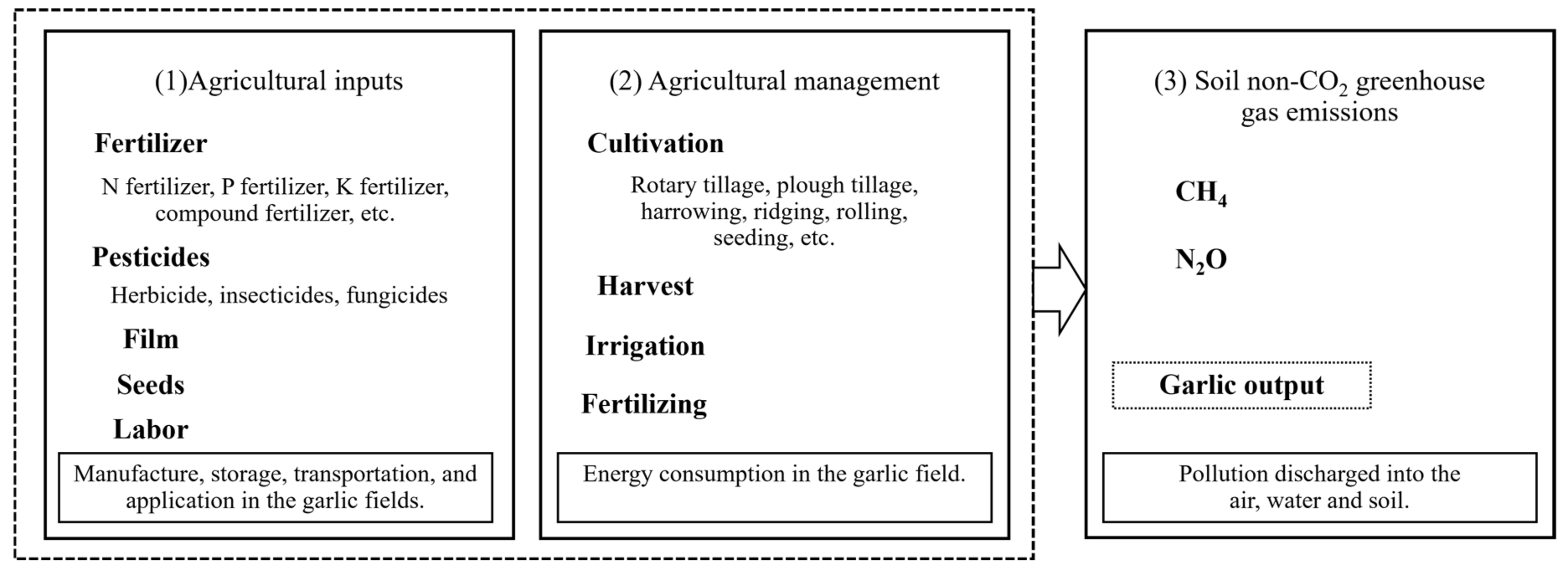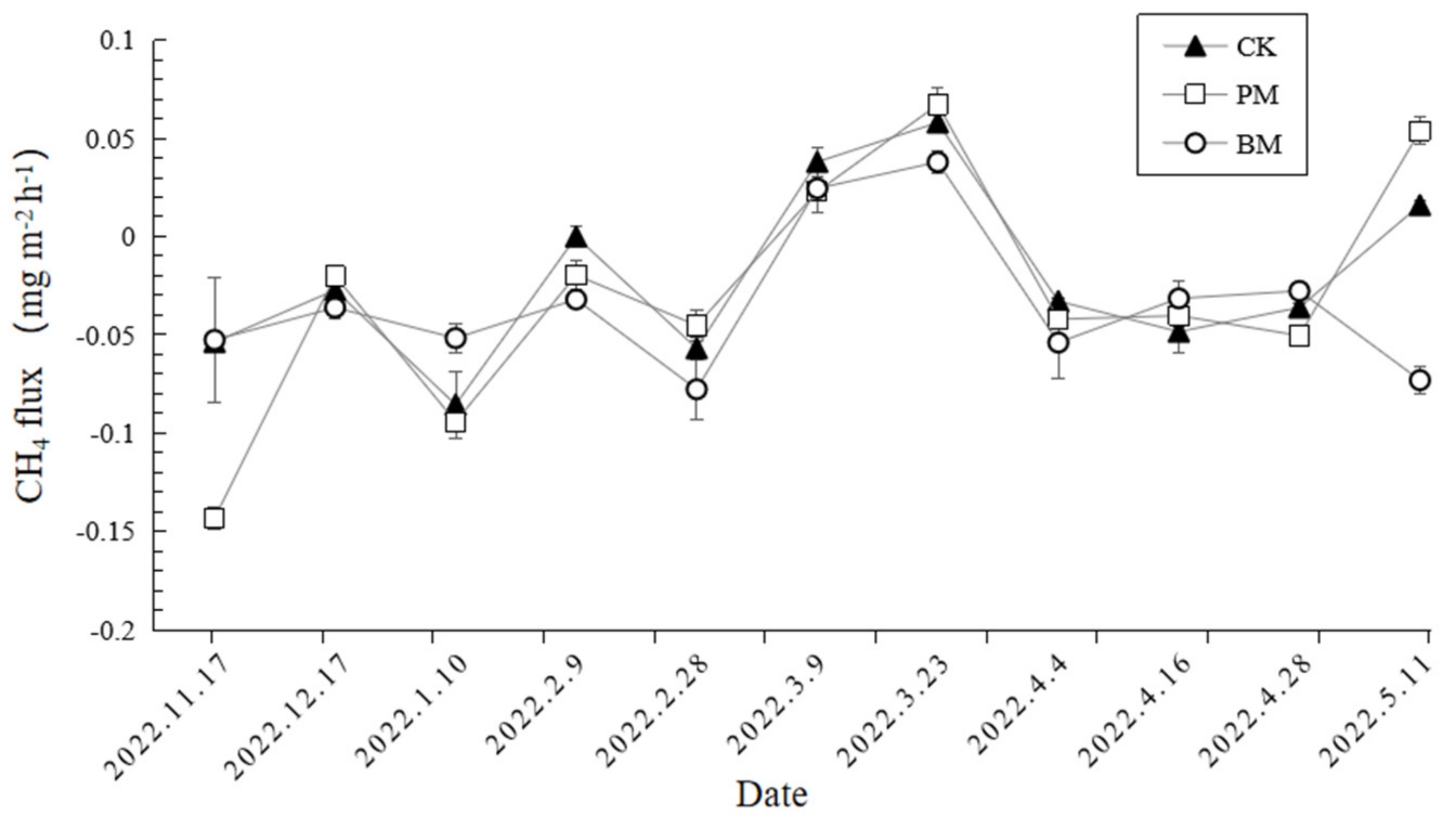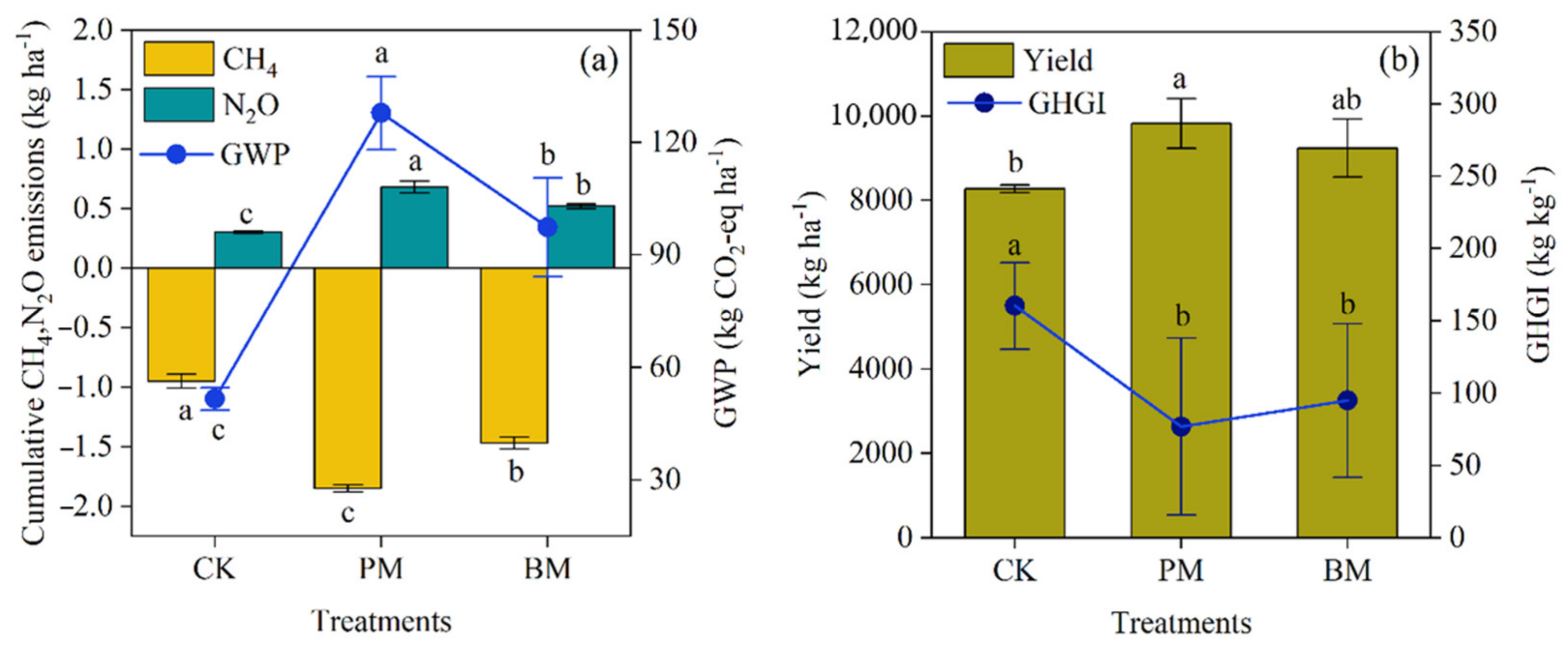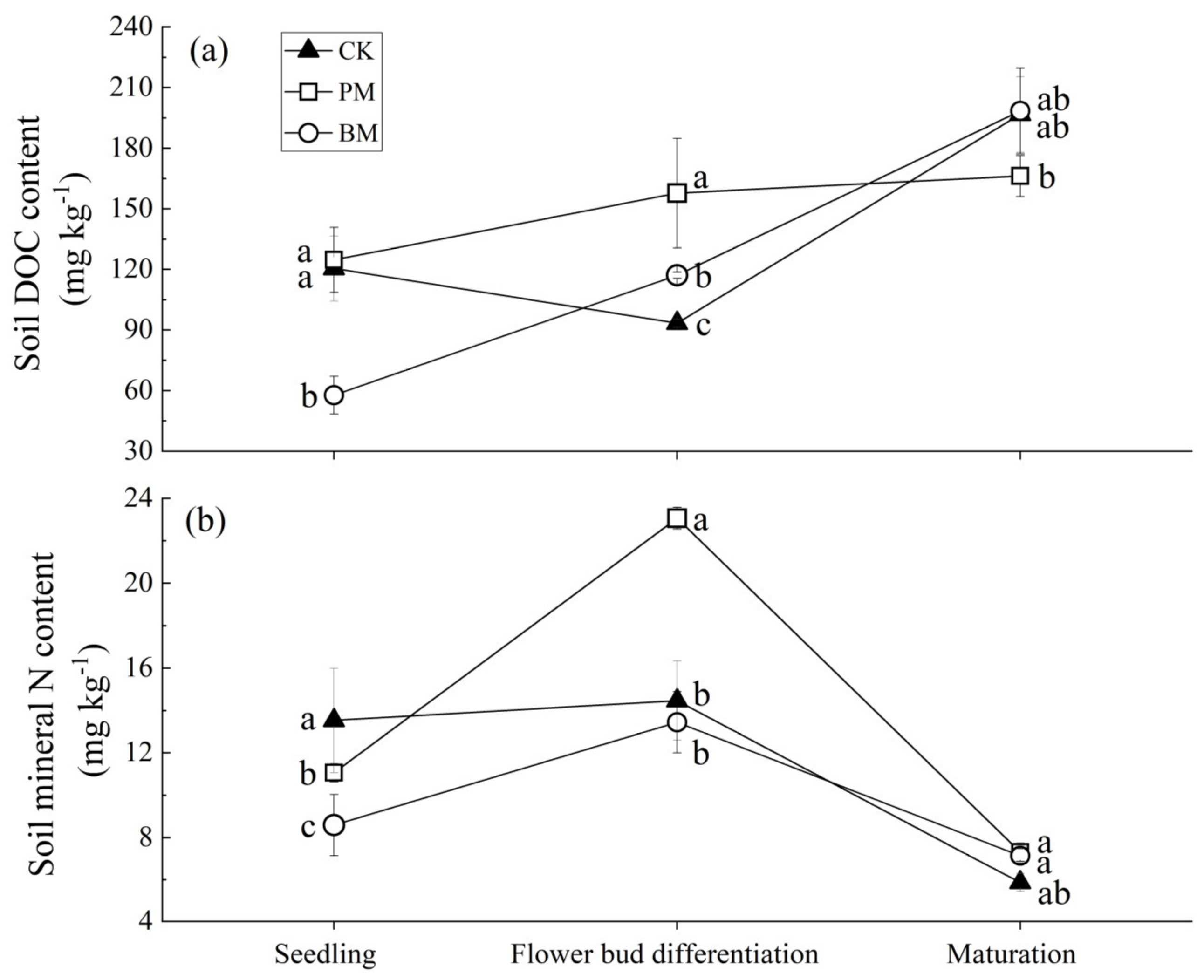Effects of Biodegradable Plastic Film Mulching on the Global Warming Potential, Carbon Footprint, and Economic Benefits of Garlic Production
Abstract
:1. Introduction
2. Materials and Methods
2.1. Experimental Site and Treatments
2.2. Gas Sampling and Measurement
2.3. Soil Sampling and Measurements
2.4. Carbon Footprint
2.5. Economic Benefit
2.6. Grain Yield Measurement (The Weight of Garlic Bulbs)
2.7. Data Analysis
3. Results
3.1. GHG Emission Characteristics of the Garlic Fields under Different Treatments
3.1.1. CH4
3.1.2. N2O
3.1.3. Yield and GHGI
3.1.4. Soil Organic Carbon and Nitrogen Contents
3.2. Indirect Carbon Emissions of Garlic Production under Different Treatments
3.3. Carbon Footprint Composition under Different Treatments
3.4. Net Ecosystem Economic Benefit of Garlic Production under Different Treatments
4. Discussion
4.1. GHG Emission Characteristics under Different Film Mulching Treatments in Garlic Production
4.1.1. CH4
4.1.2. N2O
4.2. Effects of Different Plastic Film Mulching Treatments on the Garlic Yield and GHGI
4.2.1. Yield
4.2.2. GHG and GHGI
4.3. Effects of Different Film Mulching Treatments on the Carbon Footprint and NEEB of Garlic Production
5. Conclusions
Author Contributions
Funding
Data Availability Statement
Conflicts of Interest
References
- Wang, C.; Shen, J.; Tang, H.; Inubushi, K.; Guggenberger, G.; Li, Y.; Wu, J. Greenhouse gas emissions in response to straw incorporation, water management and their interaction in a paddy field in subtropical central China. Arch. Agron. Soil Sci. 2017, 63, 171–184. [Google Scholar] [CrossRef]
- [IPCC] Intergovernmental Panel on Climate Change. Climate Change 2022: Impacts, Adaptation and Vulnerability; Cambridge University Press: Cambridge, UK, 2022. [Google Scholar]
- Xu, X.; Lan, Y. Spatial and temporal patterns of carbon footprints of grain crops in China. J. Clean. Prod. 2017, 146, 218–227. [Google Scholar] [CrossRef]
- Hu, Y.; Su, M.; Jiao, L. Peak and fall of China’s agricultural GHG emissions. J. Clean. Prod. 2023, 389, 136035. [Google Scholar] [CrossRef]
- Qian, H.; Huang, S.; Chen, J.; Wang, L.; Hungate, B.A.; Van Kessel, C.; Zhang, J.; Deng, A.; Jiang, Y.; Van Groenigen, K.J. Lower-than-expected CH4 emissions from rice paddies with rising CO2 concentrations. Glob. Chang Biol. 2020, 26, 2368–2376. [Google Scholar] [CrossRef]
- Reza, K.A.; Majid, D. Sustainability assessment of corn production in conventional and conservation tillage systems. J. Clean. Prod. 2022, 351, 131508. [Google Scholar]
- Wang, H.; Shen, M.; Hui, D.; Chen, J.; Sun, G.; Wang, X.; Lu, C.; Sheng, J.; Chen, L.; Luo, Y.; et al. Straw incorporation influences soil organic carbon sequestration, greenhouse gas emission, and crop yields in a Chinese rice (Oryza sativa L.)–wheat (Triticum aestivum L.) cropping system. Soil Tillage Res. 2019, 195, 104377. [Google Scholar] [CrossRef]
- Liu, G.W.; Ren, Y.Y.; Zhang, L.P.; Gao, Y.Y.; Li, S.Q.; Zhu, C.Y.; Tan, H. Application of biodegradable mulching film in garlic cultivation. Hunan Agric. Sci. 2023, 3, 36–39+45. (In Chinese) [Google Scholar] [CrossRef]
- Cui, Z.; Liu, X.; Chen, Y.; Guan, C.; Yang, Y.; Xu, B. Status quo, problems and countermeasures of the whole mechanized production of garlic in China. Chin. J. Agric. Mech. Chem. 2023, 44, 239–243+250. [Google Scholar] [CrossRef]
- Sun, D.; Li, H.; Wang, E.; He, W.; Hao, W.; Yan, C.; Li, Y.; Mei, X.; Zhang, Y.; Sun, Z.; et al. An overview of the use of plastic-film mulching in China to increase crop yield and water-use efficiency. Natl. Sci. Rev. 2020, 7, 1523–1526. [Google Scholar] [CrossRef] [PubMed]
- Cui, J.X.; Xu, J.Z.; Bai, R.H.; Liu, Q.; He, W.Q.; Yan, C.R. Investigation on plastic film application and recycling treatment behavior of farmers in typical regions of our country. J. Agric. Resour. Environ. 2023, 1–16. (In Chinese) [Google Scholar] [CrossRef]
- Li, Z.; He, W.Q.; Liu, E.K.; Zhou, J.L.; Liu, Q.; Yan, C.R. Research progress on the degradation process and mechanism of polyethylene film. J. Agric. Environ. Sci. 2019, 38, 268–275. (In Chinese) [Google Scholar]
- Qin, Y.; Chai, Y.; Li, R.; Li, Y.; Ma, J.; Cheng, H.; Chang, L.; Chai, S. Evaluation of straw and plastic film mulching on wheat production: A meta-analysis in Loess Plateau of China. Field Crop. Res. 2022, 275, 108333. [Google Scholar] [CrossRef]
- Yang, Y.; Li, Z.; Yan, C.; Chadwick, D.; Jones, D.L.; Liu, E.; Liu, Q.; Bai, R.; He, W. Kinetics of microplastic generation from different types of mulch films in agricultural soil. Sci. Total Environ. 2022, 814, 152572. [Google Scholar] [CrossRef] [PubMed]
- Du, Y.; Sun, J.; Wang, Z.; Zhang, Q.; Cui, B.; Niu, W. Effect of ridge film mulching and nitrogen application rate on seed quality, oil yield and nitrogen-use efficiency of winter oilseed rape in northwest China. Arch. Agron. Soil Sci. 2022, 68, 1385–1397. [Google Scholar] [CrossRef]
- Kumar, S.; Gaikwad, S.; Shekdar, A.; Kshirsagar, P. Singh Estimation method for national methane emission from solid waste landfills. Atmos. Environ. 2004, 38, 3481–3487. [Google Scholar] [CrossRef]
- Uzamurera, A.G.; Wang, P.-Y.; Zhao, Z.-Y.; Tao, X.-P.; Zhou, R.; Wang, W.-Y.; Xiong, X.-B.; Wang, S.; Wesly, K.; Tao, H.-Y.; et al. Thickness-dependent release of microplastics and phthalic acid esters from polythene and biodegradable residual films in agricultural soils and its related productivity effects. J. Hazard. Mater. 2023, 448, 130897. [Google Scholar] [CrossRef] [PubMed]
- Wang, Z.; Wu, Q.; Fan, B.; Zhang, J.; Li, W.; Zheng, X.; Lin, H.; Guo, L. Testing biodegradable films as alternatives to plastic films in enhancing cotton (Gossypium hirsutum L.) yield under mulched drip irrigation. Soil Tillage Res. 2019, 192, 196–205. [Google Scholar] [CrossRef]
- Vox, G.; Schettini, E. Evaluation of the radiometric properties of starch-based biodegradable films for crop protection. Polym. Test. 2007, 26, 639–651. [Google Scholar] [CrossRef]
- Scarascia-Mugnozza, G.; Schettini, E.; Vox, G. Effects of solar radiation on the radiometric properties of biodegradable films for agricultural applications. Biosyst. Eng. 2004, 87, 479–487. [Google Scholar] [CrossRef]
- Kang, H.; Ao, L.L.; Qin, L.Z.; Su, H.J. Field degradation process of biodegradable mulching film and its effect on maize growth. Chin. Agric. Sci. Bull. 2013, 9, 54–58. (In Chinese) [Google Scholar]
- Yin, M.; Li, Y.; Fang, H.; Chen, P. Biodegradable mulching film with an optimum degradation rate improves soil environment and enhances maize growth. Agric. Water Manag. 2019, 216, 127–137. [Google Scholar] [CrossRef]
- Yu, Y.; Zhang, Y.; Xiao, M.; Zhao, C.; Yao, H. A meta-analysis of film mulching cultivation effects on soil organic carbon and soil greenhouse gas fluxes. Catena 2021, 206, 105483. [Google Scholar] [CrossRef]
- Cuello, J.P.; Hwang, H.Y.; Gutierrez, J.; Kim, S.Y.; Kim, P.J. Impact of plastic film mulching on increasing greenhouse gas emissions in temperate upland soil during maize cultivation. Appl. Soil. Ecol. 2015, 91, 48–57. [Google Scholar] [CrossRef]
- Chen, S.-J.; Jiang, C.-S.; Ni, X.; Li, X.-X.; Hao, Q.-J. Effect of plastic film mulching on greenhouse gas emissions from rice-rapeseed rotation in cropland. Chin. J. Environ. Sci. 2019, 40, 4213–4220. (In Chinese) [Google Scholar]
- Berger, S.; Kim, Y.; Kettering, J.; Gebauer, G. Plastic mulching in agriculture—Friend or foe of N2O emissions. Agric. Ecosyst. Environ. 2013, 167, 43–51. [Google Scholar] [CrossRef]
- Hu, Y.; Ma, P.; Duan, C.; Wu, S.; Feng, H.; Zou, Y. Black plastic film combined with straw mulching delays senescence and increases summer maize yield in northwest China. Agric. Water Manag. 2020, 231, 106031. [Google Scholar] [CrossRef]
- Qin, M.; Chen, C.; Song, B.; Shen, M.; Cao, W.; Yang, H.; Zeng, G.; Gong, J. A review of biodegradable plastics to biodegradable microplastics: Another ecological threat to soil environments? J. Clean. Prod. 2021, 312, 127816. [Google Scholar] [CrossRef]
- Guo, Y.T.; Luo, X.Q.; Wang, R.; Chen, H.X.; Feng, H. Effects of biodegradable plastic film mulching on greenhouse gas emissions under wheat-maize rotation system in the Guanzhong Plain. Chin. J. Environ. Sci. 2021, 43, 2788–2801. (In Chinese) [Google Scholar]
- Maeseele, C.; Roux, P. An LCA framework to assess environmental efficiency of water reuse: Application to contrasted locations for wastewater reuse in agriculture. J. Clean. Prod. 2021, 316, 128151. [Google Scholar] [CrossRef]
- Ji, G.; Ji, H.; Cheng, K.; Liu, M.; Jiang, M.; Hu, Z.; Zhang, Y.; Hu, N.; Hu, F. Comprehensive evaluation of the carbon footprint and economic benefits of rice cultivation in Jiangsu. Soil Sci. J. 2024, 1–15. Available online: http://kns.cnki.net/kcms/detail/32.1119.P.20230423.1726.004.html (accessed on 15 February 2024).
- Hu, N.; Chen, Q.; Zhu, L. Life cycle environmental impact assessment of rice-wheat rotation system in the middle and lower reaches of the Yangtze River—A case study of Nanjing, Jiangsu. Yangtze River Basin Resour. Environ. 2019, 28, 1111–1120. [Google Scholar]
- Feng, H.; Liu, J.J.; Zhang, A.F.; Zou, S.Y.; Chen, H.S. Effects of mulching method on net carbon sinks in wheat-corn rotation farmland ecosystems. J. Agric. Mach. 2017, 48, 180–189. [Google Scholar]
- Luo, X. Characteristics of Greenhouse Gas Emissions and Carbon Footprint of Farmland under Different Mulching Measures. Master’s Thesis, Northwest Agriculture and Forestry University, Xianyang, China, 2019. [Google Scholar]
- Guo, B.; Yang, Z.; He, W.; Liu, J. Application effects and problems of biodegradable mulch. China Agric. Meteorol. 2023, 44, 977–994. [Google Scholar]
- Meng, Y.; He, W. Effects of different ridge cropping methods on water utilization efficiency and economic benefits of potato in rainfed areas. J. Henan Agric. Univ. 2018, 52, 506–513. [Google Scholar] [CrossRef]
- Zhao, C.; Chen, G.; Chai, Q.; Yin, W.; Liu, C. Analysis of soil moisture and economic benefits of corn farmland covered by one film for two years under different irrigation levels. Arid. Reg. Agric. Res. 2017, 35, 1–6. [Google Scholar]
- Li, P.; Wu, B.; Gao, Y.; Niu, J.; Chen, Y.; Ling, P.; Li, Y. Impact analysis of mulching planting mode on economic benefits of dryland huisache—A comprehensive evaluation based on entropy weighted gray correlation coupling. Arid. Zone Resour. Environ. 2021, 35, 180–188. [Google Scholar] [CrossRef]
- Liu, C.Y.; Yang, F.; Lu, X.J.; Zhao, Y.Q.; Zhang, B.W.; Fan, J.D. Effects of organic and inorganic fertilizers on growth, yield, and quality of garlic. Hunan Agric. Sci. 2021, 12, 40–43. (In Chinese) [Google Scholar]
- Zou, J.W. A Study on Greenhouse Gas (CO2, CH4, and N2O) Emissions from Rice-Winter Wheat Rotations in Southeast China. Ph.D. Thesis, Nanjing Agricultural University, Nanjing, China, 2005. [Google Scholar]
- [IPCC] Intergovernmental Panel on Climate Change. Climate Change 2013: The Physical Science Basis; Cambridge University Press: Cambridge, UK, 2013. [Google Scholar]
- Landman, W. Climate change 2007: The physical science basis. S. Afr. Geogr. J. 2010, 92, 86–87. [Google Scholar] [CrossRef]
- Jiang, P.; Xu, Q.; Xu, Z.; Cao, Z. Seasonal changes in soil labile organic carbon pools within a Phyllostachys praecox stand under high rate fertilization and winter mulch in subtropical China. For. Ecol. Manag. 2006, 236, 30–36. [Google Scholar] [CrossRef]
- Shan, H.; Zhang, Q.; Zhang, X.; Han, R.; Feng, Z. Effects of preservation, analysis method on determination of nitrate in soils. J. Instr. Anal. 2013, 32, 1466–1471. [Google Scholar]
- Xia, L.; Ti, C.; Li, B.; Xia, Y.; Yan, X. Greenhouse gas emissions and reactive nitrogen releases during the life-cycles of staple food production in China and their mitigation potential. Sci. Total Environ. 2016, 556, 116–125. [Google Scholar] [CrossRef]
- Li, S.-H.; Guo, L.-J.; Cao, C.-G.; Li, C.-F. Integrated assessment of carbon footprint, energy budget and net ecosystem economic efficiency from rice fields under different tillage modes in central China. J. Clean. Prod. 2021, 295, 126398. [Google Scholar] [CrossRef]
- Hillier, J.; Hawes, C.; Squire, G.; Hilton, A.; Wale, S.; Smith, P. The carbon footprints of food crop production. Int. J. Agric. Sustain. 2009, 7, 107–118. [Google Scholar] [CrossRef]
- Liu, C.; Wang, K.; Zheng, X. Effects of nitrification inhibitors (DCD and DMPP) on nitrous oxide emission, crop yield and nitrogen uptake in a wheat–maize cropping system. Biogeosciences 2013, 10, 2427–2437. [Google Scholar] [CrossRef]
- Jiang, H.-L.; Lei, Q.; Zhang, B.; Wu, S.-F. Effects of mulching and application of organic and chemical fertilizer on greenhouse gas emission and water and nitrogen use in summer maize farmland. Chin. J. Environ. Sci. 2022, 44, 3426–3438. [Google Scholar] [CrossRef]
- Dalal, R.C.; Allen, D.E.; Livesley, S.J.; Richards, G. Magnitude and biophysical regulators of methane emission and consumption in the Australian agricultural, forest, and submerged landscapes: A review. Plant Soil 2007, 309, 43–76. [Google Scholar] [CrossRef]
- Meng, C.; Wang, F.; Yang, K.; Shock, C.C.; Engel, B.A.; Zhang, Y.; Tao, L.; Gu, X. Small wetted proportion of drip irrigation and non-mulched treatment with manure application enhanced methane uptake in upland field. Agric. For. Meteorol. 2020, 281, 107821. [Google Scholar] [CrossRef]
- Chen, N.; Li, X.; Šimůnek, J.; Shi, H.; Hu, Q.; Zhang, Y. Evaluating the effects of biodegradable and plastic film mulching on soil temperature in a drip-irrigated field. Soil Tillage Res. 2021, 213, 105116. [Google Scholar] [CrossRef]
- Wang, Z.L.; Bai, J.; Li, Y.; Li, S.Q. Effects of nitrogen application and plastic film mulching on nitrogen uptake and allocation in dry-land spring maize. Plant. Nutr. Fert. Sci. 2019, 25, 74–84. (In Chinese) [Google Scholar]
- Zhang, K.L.; Hao, Q.J.; Feng, D.; Shi, J.L.; Shi, X.J.; Jiang, C.S. Effect of plastic film mulching on methane emission from a vegetable field. Chin. J. Environ. Sci. 2017, 38, 3451–3462. (In Chinese) [Google Scholar]
- Li, Y.; Wu, W.; Yang, J.; Cheng, K.; Smith, P.; Sun, J.; Xu, X.; Yue, Q.; Pan, G. Exploring the environmental impact of crop production in China using a comprehensive footprint approach. Sci. Total Environ. 2022, 824, 153898. [Google Scholar] [CrossRef]
- Li, B.; Fan, C.H.; Zhang, H.; Chen, Z.; Sun, L.; Xiong, Z. Combined effects of nitrogen fertilization and biochar on the net global warming potential, greenhouse gas intensity and net ecosystem economic budget in intensive vegetable agriculture in southeastern China. Atmos. Environ. 2015, 100, 10–19. (In Chinese) [Google Scholar] [CrossRef]
- Kim, G.W.; Das, S.; Hwang, H.Y.; Kim, P.J. Nitrous oxide emissions from soils amended by cover-crops and under plastic film mulching: Fluxes, emission factors and yield-scaled emissions. Atmos. Environ. 2017, 152, 377–388. [Google Scholar] [CrossRef]
- Liu, J.; Zhu, L.; Luo, S.; Bu, L.; Chen, X.; Yue, S.; Li, S. Response of nitrous oxide emission to soil mulching and nitrogen fertilization in semi-arid farmland. Agric. Ecosyst. Environ. 2014, 188, 20–28. [Google Scholar] [CrossRef]
- Pajares, S.; Bohannan, B.J.M. Ecology of nitrogen fixing, nitrifying, and denitrifying microorganisms in tropical forest soils. Front. Microbiol. 2016, 7, 1045. [Google Scholar] [CrossRef] [PubMed]
- Li, Q.; Li, H.; Zhang, S. Yield and water use efficiency of dryland potato in response to plastic film mulching on the Loess Plateau. Acta Agric. Scand. Sect. 2018, 68, 175–188. [Google Scholar] [CrossRef]
- Fang, H.; Li, Y.; Gu, X.; Yu, M.; Chen, P.; Li, Y.; Liu, F. Optimizing the impact of film mulching pattern and nitrogen application rate on maize production, gaseous N emissions, and utilization of water and nitrogen in northwest China. Agric. Water Manag. 2022, 261, 107350. [Google Scholar] [CrossRef]
- Zhang, Z.X.; Nie, T.Z.; Wang, D. The coupling effect of water, N and P with drip irrigation under plastic film on maize yield in semi-arid region of western Heilongjiang Province. China Rural. Water Hydropower 2016, 2, 1–4. (In Chinese) [Google Scholar]
- Hui, S.J.; Zhang, J.X. Effects of different mulching patterns and irrigation quotas on soil hydrothermal, nutrients and yield of sunflower farmland in Hexi Oasis. Agric. Res. Arid. Areas. 2022, 40, 212–223. (In Chinese) [Google Scholar]
- Shi, J.-L.; Hao, Q.-J.; Feng, D.; Zhang, K.-L.; Shi, X.-J.; Jiang, C.-S. Effects of plastic film mulching on methane and nitrous oxide emissions from a rice-rapeseed crop rotation. Environ. Sci. 2017, 38, 4790–4799. [Google Scholar] [CrossRef]
- Zhou, L.; Wang, F.; Zhao, W.L.; Zeng, Z.W.; Yang, D.L. Research progress of crop mulching cultivation. Hubei Agric Sci. 2019, 58, 75–81. (In Chinese) [Google Scholar]
- Yan, C.; He, W.; Xue, Y.; Liu, E.; Liu, Q. Application of biodegradable plastic film to reduce plastic film residual pollution in Chinese agriculture. Chin. J. Biotech. 2016, 32, 748–760. [Google Scholar]
- Li, S.Q.; Li, D.F.; Li, F.M.; Bai, H.Y.; Ling, L.; Wang, J. Soil ecological effects of plastic film mulching in semiarid agro-ecological system. J. Northwest AF Univ. 2003, 31, 21–29. (In Chinese) [Google Scholar]
- Lee, J.G.; Cho, S.R.; Jeong, S.T.; Hwang, H.Y.; Kim, P.J. Different response of plastic film mulching on greenhouse gas intensity (GHGI) between chemical and organic fertilization in maize upland soil. Sci. Total Environ. 2019, 696, 133827. [Google Scholar] [CrossRef] [PubMed]
- Grassini, P.; Cassman, K.G. High-yield maize with large net energy yield and small global warming intensity. Proc. Natl. Acad. Sci. USA 2012, 109, 1074–1079. [Google Scholar] [CrossRef]
- Lal, R. Constraints to adopting no-till farming in developing countries. Soil Tillage Res. 2007, 94, 1–3. [Google Scholar] [CrossRef]
- Zhang, F.; Cheng, T.-H.; Chen, X.-P.; Wang, X.-Z. Greenhouse gas emissions for typical open-field vegetable production in China. Environ. Sci. 2020, 41, 3410–3417. (In Chinese) [Google Scholar]
- Li, C.; Xiong, Y.; Huang, Q.; Xu, X.; Huang, G. Impact of irrigation and fertilization regimes on greenhouse gas emissions from soil of mulching cultivated maize (Zea mays L.) field in the upper reaches of Yellow River, China. J. Clean. Prod. 2020, 259, 120873. [Google Scholar] [CrossRef]
- Yoon, S.Y.; Kim, Y.R.; Kim, T.H.; Park, J.H.; Ahn, S.W. Study of garlic’s carbon footprint though LCA. Korean J. Org. Agric. 2012, 20, 161–172. [Google Scholar]
- He, X.; Chen, J.; Li, Y.; Chen, Y.; Zhao, G.; Ren, K.; Hu, M.; Hu, B.; Chen, Y.; Xu, Z.; et al. Seasonal dynamics of soil aggregates and associated C and N stocks in different fertilizer managements. Arch. Agron. Soil Sci. 2021, 68, 1305–1321. [Google Scholar] [CrossRef]
- Wang, Z.-B.; Wen, X.-Y.; Zhang, H.-L.; Lu, X.-H.; Chen, F. Net energy yield and carbon footprint of summer corn under different N fertilizer rates in the North China Plain. J. Integr. Agric. 2015, 14, 1534–1541. [Google Scholar] [CrossRef]
- Lee, J.G.; Chae, H.G.; Hwang, H.Y.; Kim, P.J.; Cho, S.R. Effect of plastic film mulching on maize productivity and nitrogen use efficiency under organic farming in South Korea. Sci. Total Environ. 2021, 787, 147503. [Google Scholar] [CrossRef] [PubMed]
- Zhang, D.B.; Yao, P.W.; Zhao, N.; Wang, Z.; Yu, C.W.; Cao, Q.H.; Cao, W.D.; Gao, Y.J. Responses of winter wheat production to green manure and nitrogen fertilizer on the Loess Plateau. Agron. J. 2015, 107, 361–374. [Google Scholar]
- Xu, Y.; Liang, L.; Wang, B.; Xiang, J.; Gao, M.; Fu, Z.; Long, P.; Luo, H.; Huang, C. Conversion from double-season rice to ratoon rice paddy fields reduces carbon footprint and enhances net ecosystem economic benefit. Sci. Total Environ. 2022, 813, 152550. [Google Scholar] [CrossRef]







| Treatment | Diesel (kg ha−1) | Diesel Combustion (kg ha−1) | Electricity for Irrigation (k Wh ha−1) | N Fertilizer (kg ha−1) | P Fertilizer (kg ha−1) | K Fertilizer (kg ha−1) | Herbicide (kg ha−1) | Insecticides (kg ha−1) | Fungicides (kg ha−1) | Film (kg ha−1) | Garlic Seeds (kg ha−1) | Labor Force (per ha−1) |
|---|---|---|---|---|---|---|---|---|---|---|---|---|
| CK | 97.5 | 97.5 | 75 | 420 | 180 | 150 | 4.5 | 4.5 | 3 | 0 | 1500 | 135 |
| PM | 97.5 | 97.5 | 45 | 420 | 180 | 150 | 4.5 | 4.5 | 1.8 | 67.5 | 1500 | 240 |
| BM | 97.5 | 97.5 | 45 | 420 | 180 | 150 | 4.5 | 4.5 | 1.8 | 67.5 | 1500 | 210 |
| Inputs | Carbon Emission Coefficient | Data Source |
|---|---|---|
| Diesel | 0.89 kgCO2-eq kg−1 | CLCD 0.7 |
| Diesel combustion | 4.10 kgCO2-eq kg−1 | CLCD 0.7 |
| Electricity for irrigation | 0.82 kgCO2-eq kg−1 | CLCD 0.7 |
| N fertilizer | 1.53 kgCO2-eq kg−1 | CLCD 0.7 |
| P fertilizer | 1.63 kgCO2-eq kg−1 | CLCD 0.7 |
| K fertilizer | 0.65 kgCO2-eq kg−1 | CLCD 0.7 |
| Herbicide | 10.15 kgCO2-eq kg−1 | Ecoinvent 2.2 |
| Insecticides | 16.61 kgCO2-eq kg−1 | Ecoinvent 2.2 |
| Fungicides | 10.57 kgCO2-eq kg−1 | Ecoinvent 2.2 |
| Film | 2.49/6.91 kgCO2-eq kg−1 | CPCD 2023 |
| Garlic seeds | 0.18 kgCO2-eq kg−1 | CPCD 2023 |
| Labor force | 0.86 kgCO2-eq d−1 | Liu et al., 2013 [48] |
| Item | Unit | CK | PM | BM |
|---|---|---|---|---|
| CH4 emissions | kg CO2-eq ha−1 | −26.60 ± 1.35 a | −51.80 ± 1.55 c | −41.16 ± 0.92 b |
| N2O emissions | kg CO2-eq ha−1 | 79.50 ± 1.49 c | 180.2 ± 2.66 a | 137.80 ± 3.22 b |
| Agriculture input | kg CO2-eq ha−1 | 2119.76 ± 0 c | 2639.20 ± 0 a | 2,315.05 ± 0 b |
| Garlic yield | kg CO2-eq ha−1 | 8270.00 ± 90 b | 9830.00 ± 590 a | 9240.00 ± 690 ab |
| GHG emissions | kg CO2-eq ha−1 | 2171.34 ± 0 c | 2767.09 ± 0 a | 2412.43 ± 0 b |
| Carbon footprint | kg CO2-eq ha−1 | 0.26 ± 0.04 b | 0.28 ± 0.03 a | 0.26 ± 0.03 b |
| Treatment | Production (kg ha−1) | Production Costs (CNY ha−1) | Production Costs (CNY ha−1) | GWP Costs (CNY ha−1) | NEEB (CNY ha−1) |
|---|---|---|---|---|---|
| CK | 8270.00 ± 90 b | 62,025 ± 0 c | 28,950 ± 0 c | 3.40 ± 0.20 c | 33,071.60 ± 86 b |
| PM | 9830.00 ± 590 a | 73,725 ± 0 a | 36,750 ± 0 a | 8.44 ± 0.64 a | 36,966.56 ± 590 a |
| BM | 9240.00 ± 690 ab | 69,300 ± 0 b | 33,150 ± 0 b | 6.43 ± 0.87 b | 36,143.57 ± 635 a |
Disclaimer/Publisher’s Note: The statements, opinions and data contained in all publications are solely those of the individual author(s) and contributor(s) and not of MDPI and/or the editor(s). MDPI and/or the editor(s) disclaim responsibility for any injury to people or property resulting from any ideas, methods, instructions or products referred to in the content. |
© 2024 by the authors. Licensee MDPI, Basel, Switzerland. This article is an open access article distributed under the terms and conditions of the Creative Commons Attribution (CC BY) license (https://creativecommons.org/licenses/by/4.0/).
Share and Cite
Chen, Q.; Hu, N.; Zhang, Q.; Sun, H.; Zhu, L. Effects of Biodegradable Plastic Film Mulching on the Global Warming Potential, Carbon Footprint, and Economic Benefits of Garlic Production. Agronomy 2024, 14, 504. https://doi.org/10.3390/agronomy14030504
Chen Q, Hu N, Zhang Q, Sun H, Zhu L. Effects of Biodegradable Plastic Film Mulching on the Global Warming Potential, Carbon Footprint, and Economic Benefits of Garlic Production. Agronomy. 2024; 14(3):504. https://doi.org/10.3390/agronomy14030504
Chicago/Turabian StyleChen, Qian, Naijuan Hu, Qian Zhang, Hongwu Sun, and Liqun Zhu. 2024. "Effects of Biodegradable Plastic Film Mulching on the Global Warming Potential, Carbon Footprint, and Economic Benefits of Garlic Production" Agronomy 14, no. 3: 504. https://doi.org/10.3390/agronomy14030504
APA StyleChen, Q., Hu, N., Zhang, Q., Sun, H., & Zhu, L. (2024). Effects of Biodegradable Plastic Film Mulching on the Global Warming Potential, Carbon Footprint, and Economic Benefits of Garlic Production. Agronomy, 14(3), 504. https://doi.org/10.3390/agronomy14030504





